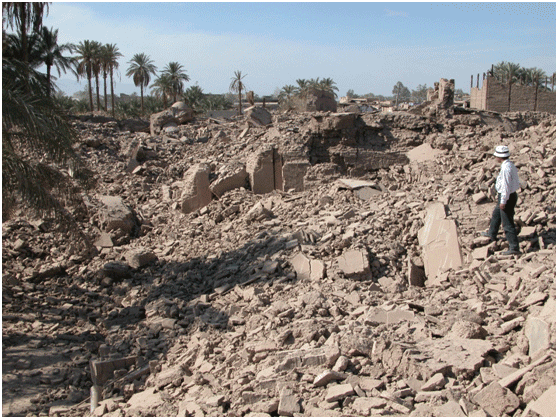Earthquakes without frontiers - new five year study on continental interiors
University of Cambridge, UK: A new five-year study is to target a relatively neglected area of earthquake research - the ten million square kilometres of the Alpine-Himalayan belt stretching from Italy, Greece and Turkey, across the Middle East, Iran and central Asia, to China. Earthquakes in continental interiors such as these lead to significantly more deaths than on the better-studied oceanic plate boundaries because they often take place on unknown faults.
The 'Earthquakes without frontiers' project will not only pinpoint faults in the Earth's crust, but also understand the vulnerabilities of communities at risk, and communicate this new knowledge to policymakers. Led by the University of Cambridge, the study involves physical and social scientists from six UK universities and four institutes and organisations, together with collaborators in some of the most earthquake-prone regions of the world.
An important feature of the work is to build multinational collaborations that span entire regions and connect scientists working in affected areas with a larger international community of scientists.

Bam, south-eastern Iran, after the 2003 earthquake (Photo courtesy of Professor James Jackson)
"To approach the levels of resilience that are achievable in well-prepared countries," said Professor James Jackson, from the Department of Earth Sciences and the project's leader, "societies in these regions need to be able to make appropriate decisions about where to concentrate resources if we are to avoid the scale of recent catastrophes. During the past 120 years, there have been about 130 earthquakes in which a thousand or more people have died. Of these, about 100 took place in continental interiors, causing at least 1,400,000 deaths."
Earthquakes happen when faults move. But faults in the continental interiors are dispersed over thousands of kilometres, whereas those on ocean-margin plate boundaries are confined to narrow zones, like the Pacific Ring of Fire or the San Andreas Fault. This localisation of activity also means that earthquakes recur more frequently in the same place on the oceanic plate boundaries than in the continents, where earthquakes on the same fault may only repeat every few thousand years rather than every few centuries - well beyond human memory or recorded history.
As a result, communities living in continental interiors are frequently unaware of the faults beneath them and the seismic hazard they pose. Unexpected earthquakes in Bam, Iran in 2003, Muzzafarabad, Pakistan in 2005 and Wenchuan, China in 2008, for instance, collectively resulted in 175,000 deaths - a death rate that can reach 30 per cent of the local population. In striking contrast, death rates of 0.1 per cent and 0.4 per cent of the local population resulted from the earthquakes in February 2011 in Christchurch New Zealand and March 2011 in Japan, respectively. In both these countries, strict building codes and earthquake mitigation strategies were in operation.
Another reason for the severity of seismic impact in continental regions is that the position of cities and trade routes, particularly in arid climates, is often determined by the availability of ground water, which in turn is related to the position of faults, which act as spring lines. "In the Middle East and central Asia this is a real problem," added Jackson. "Vast cities such as Tehran, Tabriz and Ashkhabad have grown up around faults because of water. Large urban populations are now concentrated in vulnerable places, which is why so many recent earthquakes look like bull's eye targeting of cities."
With funding from the Natural Environment Research Council and the Economic and Social Research Council, the team will use state-of the-art ground- and space-based technology to examine in forensic detail the link between earthquake faults and the landscape they have created. To be able to do this in relation to slowly-moving faults in continental interiors is a recent breakthrough. "The idea is to be able to read the geological signals in the landscape before a fault moves in an earthquake, so preparing people for the hazard where they live," said Jackson.
Working alongside the physical scientists are social scientists with extensive experience of exploring the vulnerability and resilience of communities in disaster-prone regions. A third arm of the team comprises experienced practitioners in the communication of scientific knowledge to policy makers, with the aim of easing the translation of research into more effective seismic mitigation policies, improved infrastructure and enhanced crisis management.
Many earthquakes occur in regions that are not only less able to cope with catastrophes but also have fewer scientists and resources to build local understanding of exposure to seismic threat. The 2003 Bam earthquake in Iran, for instance, was a huge national trauma and important to understand, because it revealed many lessons relevant to Bam and elsewhere. It is now known what happened, but this required international collaboration, which has also fostered the development of Iranian earthquake science. This raising of national capability in vulnerable countries is an important aspect of the new project.
"When earthquakes happen, the Earth is doing seismic experiments," added Jackson. "Our job is to interpret the results to get a better idea of what we are dealing with, as well as to communicate this to the people who can do something about lessening the risk."
'Earthquakes without frontiers' comprises scientists from Cambridge, Durham, Hull, Leeds, Northumbria and Oxford universities, from the Overseas Development Institute, British Geological Survey, National Centre of Earth Observation and Institute of Hazard, Risk and Resilience, as well as collaborators in China, Kazakhstan, Kyrgyzstan, India, Italy, Greece, Turkey, Iran.